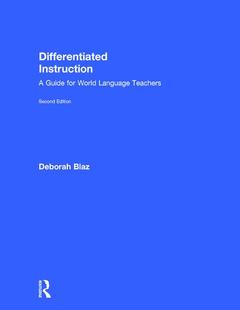Differentiated Instruction (2nd Ed.) A Guide for World Language Teachers
Auteur : Blaz Deborah

In this new edition of a bestseller, author Deborah Blaz helps you differentiate lessons for your world language students based on their learning styles, interests, prior knowledge, and comfort zones. This practical book uses brain-based teaching strategies to help students of all ability levels thrive in a rigorous differentiated learning environment. Each chapter provides classroom-tested activities and tiered lesson plans to help you teach vocabulary, speaking, listening, reading, and writing in world language classes in ways that are interactive, engaging, and effective for all learners.
Features new to this edition include:
- Sample thematic units to make your lessons more authentic and immersive
- New strategies for using technology to differentiate world language instruction
- Additional checklists, rubrics, and feedback forms to help you organize your lesson plans and track students? progress
- New connections to the Common Core State Standards, the ACTFL Standards, Webb?s Depth of Knowledge, and Bloom?s Taxonomy
You?ll also learn how to differentiate assessment effectively to help all students show their full potential. Classroom-ready tools and templates can be downloaded as free eResources from our website (www.routledge.com/9781138906181) for immediate use.
eResources
I. DIFFERENTIATED INSTRUCTION: WHAT IT IS/ WHAT IT ISN’T
What is Differentiated Instruction?
What Differentiated Instruction IS
What Differentiation is NOT
Some Research to Support Differentiation
II. FROM CONTENT TO PROCESS TO PRODUCT
Content, or What to Teach
Process, or How to Practice
Product, or How to Assess
Preparing Yourself
Preparing the Students
Management Issues and Ideas
III. PLANNING A DIFFERENTIATED UNIT
Identify What Is to Be Taught (Content)
Pre-assess Students’ Needs and Capabilities
Choose the Form(s) of Assessment to Be Used (Product )
Decide on the Method of Presentation
Classroom Environment
Select a Variety of Learning Strategies (Process)
Sample Units
Learning Centers
Interdisciplinary Units
Cultural Adventure Unit: Language in Our Community (Spanish)
Project-Based Learning Unit
Checklist for a Differentiated Lesson or Unit
Checklist for Observing a Lesson/Unit that Uses Differentiated Instruction
IV. IDEAS SMORGASBORD
Vocabulary
Speaking/Listening
Reading
Post-Reading Projects/Strategies
Writing
Review
Other
V. Differentiated Assessment
Use Choice
Use Context
Use Variety
Managing Grades
VI. Reflections on Differentiation
Graphics
Frequently Asked Questions and Answers.
APPENDIX A: CHECKLISTS
APPENDIX B: THE LANGUAGE OF DIFFERENTIATED INSTRUCTION: KEY WORDS AND CONCEPTS
APPENDIX C: LISTS OF ACTIVITIES AND STRATEGIES BY STANDARDS
Common Core
ACTFL
References
Deborah Blaz has taught French to grades 7-12 for the past 36 years in Indiana. She also serves as the World Language Department Chair at her school.
Date de parution : 03-2016
21x28 cm
Ancienne édition
Accéder à la nouvelle édition.
Date de parution : 03-2016
21x28 cm
Ancienne édition
Accéder à la nouvelle édition.
Thèmes de Differentiated Instruction :
Mots-clés :
Deb Blaz; Deborah Blaz; ACTFL standards; Common Core and foreign language teachers; differentiated assessment; foreign languages; ACTFL Standard; differentiated instruction for world languages; Ta Te; Es Ta; Fi Ll; Student Group Performance; DOK Level; Genius Hour; SL 1a; Past Tenses; Fi Ve; Pa Ti; Differentiated Instruction; AAT; Fi Fteen Points; Main Character; Independent Study; Refl Exive Verbs; Holistic Rubric; Performance Assessment; Bloom’s Create; Gardner’s Multiple Intelligences; Tiered Lessons; GAFE; Home Town



